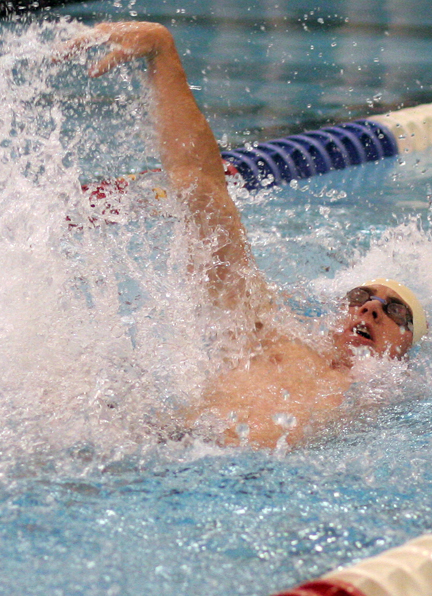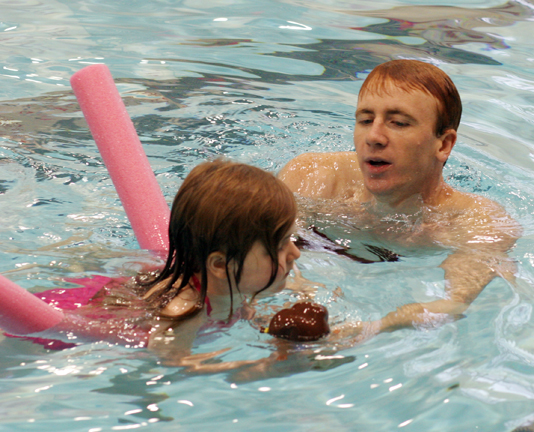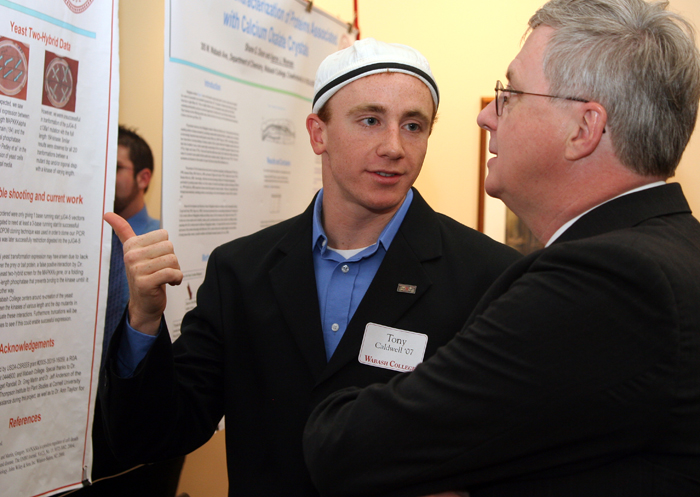A Motto Made Fleshby Hugh Vandivier |
| Printer-friendly version | Email this article |
|
At times, "Wabash Always Fights!" can begin to tread the dangerous waters of becoming clich™. Then along comes one of its own whose unflappable mental attitude reinforces the motto for the men of this small liberal arts college in west central Indiana.
A senior backstroker from Washington, Iowa, Tony Caldwell exemplifies the never-say-die attitude and total commitment that inspires his teammates in and out of the pool.
"When he commits to something, he’s involved completely," says Wabash head swimming coach Peter Casares. "I’ve never seen one of my swimmers with so much focus toward his passions."
Caldwell was the first alternate to the NCAA Division III Men’s Swimming and Diving Championships his sophomore year. (During the North Coast Athletic Conference Championships, he went a :52.05 B-cut in the 100 backstoke; a :52.04 was invited to the meet that year.) In fact, he was, and still is, the fastest backstroker in the history of DIII swimming not to make the meet, which has taken a :52.2 in the last two years.
During that meet in 2005, Caldwell earned All-Conference Swimmer recognition three times in what many deem the fastest conference in the country. (The NCAC includes powerhouse Kenyon College, which has won a record 27 consecutive national titles.) Caldwell broke the school record in the 50 and 100 back and then won Team MVP, an honor voted on by his teammates.
Then he did the unthinkable: he took his junior year off. "He had worked so hard and felt burned out with the entire experience," Casares relates. "That .01 of a second was a hard pill to swallow."
During his time away from the pool, Caldwell focused on his increased workload of lab sciences, his fraternity and other leadership activities on campus. He even spent his fall break with other Wabash students traveling down to Pass Christian, Mississippi, to help that community recover from Hurricane Katrina.
This time made Caldwell realize that he still had some unfinished business in the pool. "In the spring of his junior year," recalls Coach Casares, "he took me out to lunch to tell me he would like to join the team again—if it was OK with me. He knew he had made a mistake and wanted back in. He promised to redouble his efforts to make up for the lost time."
Taking a year off from this sport and returning to it can be disastrous. Swimming relies too much on training and big meet experience, not to mention the cautionary tales of countless swimmers who have failed trying to make similar comebacks. "I explained how difficult it would be and how a year off has never led to any great performances in the past," says Casares. "He understood and took on the challenge anyway."
In the interim, Wabash had continued to build a team with potential to match the squads that swaggered their way onto the National scene in the ’90s, recruiting two solidly talented classes. So Caldwell came back, one of only two seniors, not knowing more than two-thirds of his teammates.
"Tony is a different breed," Casares observes, "and I knew it was going to be hard. But if anyone could do it—or at least give it what it takes—he could. So he came back and trained and competed like one of this country’s best right from the beginning, like someone who never took a year off from the sport."
All that time, Caldwell began to feel tired and sick. Rather than make a big deal of the situation, he quietly went to the doctor for some blood work. The results revealed the bane of many college students: He had been swimming with mononucleosis for at least two weeks.
More annoyed than devastated, the senior leader informed the team that he wouldn’t miss the biggest meet of the year against their archrivals, DePauw University. The football rivalry fought each fall in the annual Monon Bell Classic transfers to all manner of competition between the two schools, especially in the pool, where the two teams are often evenly matched in talent. "It simply isn’t an option," he wrote. In that e-mail, he also promised that he would win all three events he was entered in.
He proceeded to make good on his promise.
Caldwell swam a :25.1 to lead off the medley relay off, giving the Little Giants more than a one second lead on DePauw and starting the meet with a 1-2 punch of first and second. He then won the 100 back with a time of :53.7 and finished up the trifecta with a win in the 200 backstoke, clocking a 2:00.1 (just one second off his lifetime best).
Exhausted, beaten up and nearly passing out, the steely senior remained on deck and cheered on his team while they continued to attack their races against a talented opponent. At the end of the meet, the inspired Little Giants had shocked the Tigers with a convincing 172.5 to 127.5 victory.
"He put this team on his back and carried them to victory," Casares notes. "It was simply legendary."
Virtually taking the next two weeks off to recover, Caldwell then showed up at the Nike Cup at Kenyon against some of the best teams in Division III. He jumped in—still extremely weak—and turned out to be one of Wabash’s biggest point winners of the meet. Caldwell lead all of the medley relay events to times that rank in the top 10 in the country at that midway point in the season. Casares was incredulous. "This is getting ridiculous," he wrote in his Lanelines blog. "I can’t believe what he has accomplished—and it’s only December!"
By the post-Christmas training trip in Deerfield Beach, Florida, Caldwell was managing two-a-days with ease and studying for January comprehensive examinations like a pro. He continued to excel in his January meets in preparation for the Conference meet in Canton, Ohio, once again.
Then adversity struck once again.
As a result, his swims were forced. He swam a 52.45 in the 100 back: four-tenths slower than his current school record. "We were happy to see him scoring us fourth place points again at the conference meet," Casares notes, "but we all hoped for a little more, especially after the senior year he had put together."
He worked through the meet, getting faster with every swim and improving along the way, but nothing spectacular happened. Later, Coach Casares would counsel that Caldwell needed to "relearn" that type of pressure and what a big meet experience feels like.
With the next week came one last opportunity: the "last chance meet" at Kenyon’s new fast and glittering Aquatic Center. Now, last chance meets become an olio of shaved and tapered swimmers trying desperately for one magical fast swim that punches the ticket to Nationals. As such, the danger is letting that desperation take hold.
Caldwell began the day leading off the 400 medley relay in a :52.98 backstroke split. He was out fairly smooth in a :25.5, but he tried too hard, struggling to bring home the second 50 of his race. About an hour later—and with a 200 medley relay under his belt—he jumped in with another 100 backstroke, going out in a :26.4 and ending up with a :53.00. This time the first 50 was too slow, but :26.6 on the way home showed promise.
Twenty minutes after that, it’s time for his last chance, a 100 backstroke time trial and what could be the last swim of his career. Caldwell tells his coach, "I’m not feeling it today, but I’m going to go out fast." Casares replies, "Just breathe a lot that first 50. Get enough oxygen to hold on…(pause, and pause again)...pleeease!" Caldwell stroked out in :25.31, and it looked easy.
"My heart rate just about doubles," recalls Casares. "As I am watching the second 50 unfold, I like the pace he is keeping, but I notice the fatigue of a third 100 is setting in." As Caldwell churned into the wall, the coach took a quick look at the clock. "I see 48...49...then I look back down at Tony. Then he touches...and the clock pauses for what seems like an eternity." Finally, it registered a number worthy of a double-take: 51.88. It’s a new Wabash school record and what would become a 10th seed for the NCAA championships when all the swims were recorded.
"How many athletes today will risk another chance of failure when it seems like failure is a given?" muses the Wabash coach. "In fact, what coach isn’t thinking, ‘This van ride is going to be tough if I encourage hi m to try on more time and he fails three times instead of two.’?
"Tony taught me a lot this year," he continues, "most importantly, always to risk failure if there is a chance of success, a chance for victory. When Tony began to doubt himself after two failures, I coached him as he had coached me all year. I told him he was trying again. To his credit, he understood where I was coming from and went 1.12 seconds faster less than 20 minutes after his last attempt."
It’s the team’s first invitations to "the show" since 2001, and Casares’ first opportunity to coach at the national level since his last job, interim head coach at Kenyon. So you can understand if he’s a bit giddy. "You want to talk about never giving up? You want to talk about a vision for success? You want to talk about hard work, sacrifice, trust? Tony is the man to talk to.
"You want to talk about believing in yourself, beyond a shadow of a doubt, when you have every reason to accept failure and everyone around you would understand? Every team in this country would be better if Tony was there with them."
Regardless of his performance in Houston, Caldwell has a job with pharmaceutical giant Eli Lilly lined up upon his graduation from Wabash in May. And he’ll have all the tools he needs to be a success in life, no matter what adversities he may face.
After all, Wabash always fights.
In photos: Caldwell in action during the NCAC meet; giving swim lessons to Crawfordsville school kids; explaining his chemistry research to Wabash President Pat White.
|



